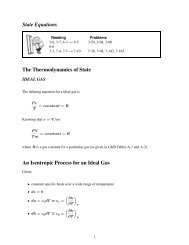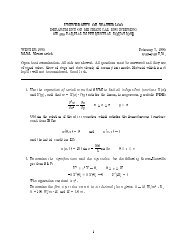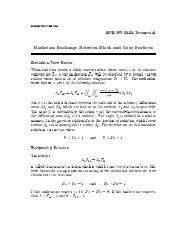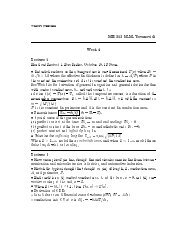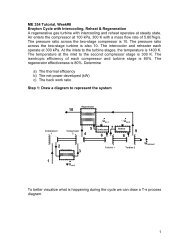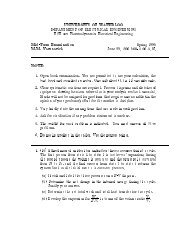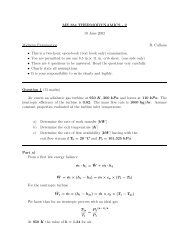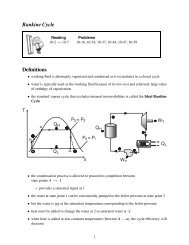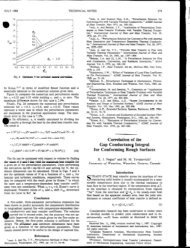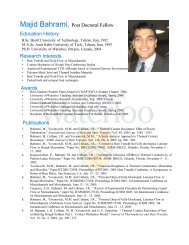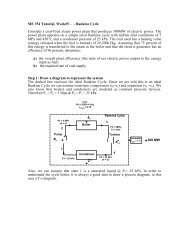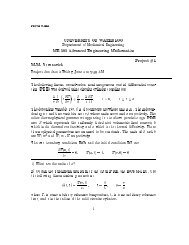Solution
Solution
Solution
Create successful ePaper yourself
Turn your PDF publications into a flip-book with our unique Google optimized e-Paper software.
12.16<br />
Borgnakke and Sonntag<br />
A large stationary Brayton cycle gas-turbine power plant delivers a power output<br />
of 100 MW to an electric generator. The minimum temperature in the cycle is 300<br />
K, and the maximum temperature is 1600 K. The minimum pressure in the cycle<br />
is 100 kPa, and the compressor pressure ratio is 14 to 1. Calculate the power<br />
output of the turbine. What fraction of the turbine output is required to drive the<br />
compressor? What is the thermal efficiency of the cycle?<br />
<strong>Solution</strong>:<br />
Brayton cycle so this means:<br />
Minimum T: T 1 = 300 K<br />
Maximum T: T 3 = 1600 K<br />
Pressure ratio: P 2 /P 1 = 14<br />
Solve using constant C P0<br />
Compression in compressor: s 2 = s 1 ⇒ Implemented in Eq.8.32<br />
k-1<br />
T2 = T1 (P2 /P1 ) k 0.286<br />
= 300(14) = 638.1 K<br />
T<br />
2<br />
1<br />
P<br />
3<br />
4<br />
P = 100 kPa<br />
s<br />
w C = h 2 - h 1 = C P0 (T 2 - T 1 ) = 1.004 (638.1 - 300) = 339.5 kJ/kg<br />
Expansion in turbine: s 4 = s 3 ⇒ Implemented in Eq.8.32<br />
k-1<br />
T4 = T3 (P4 /P3 ) k = 1600 (1/14) 0.286 = 752.2 K<br />
w T = h 3 − h 4 = C P0 (T 3 − T 4 ) = 1.004 (1600 − 752.2) = 851.2 kJ/kg<br />
w NET = 851.2 - 339.5 = 511.7 kJ/kg<br />
Do the overall net and cycle efficiency<br />
m . = W .<br />
NET /w NET<br />
= 100000/511.7 = 195.4 kg/s<br />
W .<br />
T = m. wT = 195.4 × 851.2 = 166.32 MW<br />
w C /w T = 339.5/851.2 = 0.399<br />
Energy input is from the combustor<br />
q H = C P0 (T 3 - T 2 ) = 1.004 (1600 - 638.1) = 965.7 kJ/kg<br />
η TH = w NET /q H = 511.7/965.7 = 0.530<br />
Excerpts from this work may be reproduced by instructors for distribution on a not-for-profit basis for<br />
testing or instructional purposes only to students enrolled in courses for which this textbook has been<br />
adopted. Any other reproduction or translation of this work beyond that permitted by Sections 107 or 108<br />
of the 1976 United States Copyright Act without the permission of the copyright owner is unlawful.
12.17<br />
Borgnakke and Sonntag<br />
Consider an ideal air-standard Brayton cycle in which the air into the compressor<br />
is at 100 kPa, 20°C, and the pressure ratio across the compressor is 12:1. The<br />
maximum temperature in the cycle is 1100°C, and the air flow rate is 10 kg/s.<br />
Assume constant specific heat for the air, value from Table A.5. Determine the<br />
compressor work, the turbine work, and the thermal efficiency of the cycle.<br />
<strong>Solution</strong>:<br />
P<br />
2 3<br />
s<br />
1<br />
s<br />
4<br />
v<br />
T<br />
2<br />
1<br />
P<br />
3<br />
4<br />
P = 100 kPa<br />
s<br />
Compression ratio<br />
P 2<br />
P 1 = 12<br />
Max temperature<br />
T 3 = 1100 o C<br />
m . = 10 kg/s<br />
The compression is reversible and adiabatic so constant s. From Eq.8.32<br />
T 2 = T 1⎝ ⎜ ⎛<br />
k-1<br />
P2 P1 ⎞ k 0.286<br />
⎟ = 293.2(12) = 596.8 K<br />
⎠<br />
Energy equation with compressor work in<br />
w C = - 1 w 2 = C P0 (T 2 - T 1 ) = 1.004(596.8 - 293.2) = 304.8 kJ/kg<br />
The expansion is reversible and adiabatic so constant s. From Eq.8.32<br />
T 4 = T 3⎝ ⎜ ⎛<br />
k-1<br />
P4 P3 ⎞ k<br />
⎟ = 1373.2⎝⎜ ⎠<br />
⎛ 1 ⎞<br />
12<br />
⎟<br />
⎠<br />
Energy equation with turbine work out<br />
0.286<br />
= 674.7 K<br />
w T = C P0 (T 3 - T 4 ) = 1.004(1373.2 - 674.7) = 701.3 kJ/kg<br />
Scale the work with the mass flow rate<br />
W .<br />
C = m. wC = 3048 kW, W .<br />
T = m. wT = 7013 kW<br />
Energy added by the combustion process<br />
q H = C P0 (T 3 - T 2 ) = 1.004(1373.2 - 596.8) = 779.5 kJ/kg<br />
η TH = w NET /q H = (701.3 - 304.8)/779.5 = 0.509<br />
Excerpts from this work may be reproduced by instructors for distribution on a not-for-profit basis for<br />
testing or instructional purposes only to students enrolled in courses for which this textbook has been<br />
adopted. Any other reproduction or translation of this work beyond that permitted by Sections 107 or 108<br />
of the 1976 United States Copyright Act without the permission of the copyright owner is unlawful.
12.18<br />
Borgnakke and Sonntag<br />
Repeat Problem 12.17, but assume variable specific heat for the air, table A.7.<br />
Consider an ideal air-standard Brayton cycle in which the air into the compressor<br />
is at 100 kPa, 20°C, and the pressure ratio across the compressor is 12:1. The<br />
maximum temperature in the cycle is 1100 o C, and the air flow rate is 10 kg/s.<br />
Assume constant specific heat for the air, value from Table A.5. Determine the<br />
compressor work, the turbine work, and the thermal efficiency of the cycle.<br />
<strong>Solution</strong>:<br />
From A.7: h1 = 293.6 kJ/kg, s o<br />
T1 = 6.84597 kJ/kg K<br />
The compression is reversible and adiabatic so constant s. From Eq.8.28<br />
s2 = s1 ⇒ s o<br />
T2 = so<br />
T1 + Rln(P2 /P1 ) = 6.84597 + 0.287ln12 = 7.55914<br />
⇒ T 2 = 590 K, h 2 = 597.2 kJ/kg<br />
Energy equation with compressor work in<br />
w C = - 1 w 2 = h 2 - h 1 = 597.2 - 293.6 = 303.6 kJ/kg<br />
The expansion is reversible and adiabatic so constant s. From Eq.8.28<br />
From A.7: h3 = 1483.1 kJ/kg, s o<br />
T3 = 8.50554 kJ/kg K<br />
s4 = s3 ⇒ s o<br />
T4 = so<br />
T3 + Rln(P4 /P3 ) = 8.50554 + 0.287ln(1/12) = 7.79237<br />
⇒ T 4 = 734.8 K, h 4 = 751.1 kJ/kg<br />
Energy equation with turbine work out<br />
w T = h 3 - h 4 = 1483.1 - 751.1 = 732 kJ/kg<br />
Scale the work with the mass flow rate<br />
⇒ W .<br />
C = m. wC = 3036 kW, W .<br />
T = m. wT = 7320 kW<br />
Energy added by the combustion process<br />
q H = h 3 - h 2 = 1483.1 - 597.2 = 885.9 kJ/kg<br />
w NET = w T - w C = 732 - 303.6 = 428.4 kJ/kg<br />
η TH = w NET /q H = 428.4/885.9 = 0.484<br />
Excerpts from this work may be reproduced by instructors for distribution on a not-for-profit basis for<br />
testing or instructional purposes only to students enrolled in courses for which this textbook has been<br />
adopted. Any other reproduction or translation of this work beyond that permitted by Sections 107 or 108<br />
of the 1976 United States Copyright Act without the permission of the copyright owner is unlawful.
12.29<br />
Borgnakke and Sonntag<br />
A two-stage air compressor has an intercooler between the two stages as shown in<br />
Fig. P12.29. The inlet state is 100 kPa, 290 K, and the final exit pressure is 1.6<br />
MPa. Assume that the constant pressure intercooler cools the air to the inlet<br />
temperature, T 3 = T 1. It can be shown that the optimal pressure, P 2 = (P 1P 4) 1/2 ,<br />
for minimum total compressor work. Find the specific compressor works and the<br />
intercooler heat transfer for the optimal P 2.<br />
<strong>Solution</strong>:<br />
Optimal intercooler pressure P 2 = 100 × 1600 = 400 kPa<br />
1: h1 = 290.43 kJ/kg, s o<br />
T1 = 6.83521 kJ/kg K<br />
C.V. C1: w C1 = h 2 - h 1, s 2 = s 1 leading to Eq.8.28<br />
⇒ s o<br />
T2 = so<br />
T1 + R ln(P2/P1) = 6.83521 + 0.287 ln 4 = 7.2331 kJ/kg K<br />
⇒ T 2 = 430.3 K, h 2 = 432.05 kJ/kg<br />
w C1 = 432.05 - 290.43 = 141.6 kJ/kg<br />
C.V. Cooler: T 3 = T 1 ⇒ h 3 = h 1<br />
q OUT = h 2 - h 3 = h 2 - h 1 = w C1 = 141.6 kJ/kg<br />
C.V. C2: T3 = T1, s4 = s3 and since s o<br />
T3 = so<br />
T1 , P4/P3 = P2/P1 ⇒ s o<br />
T4 = so<br />
T3 + R ln(P4/P3) = s o<br />
T2 , so we have T4 = T2 Thus we get w C2 = w C1 = 141.6 kJ/kg<br />
P<br />
4<br />
3<br />
2<br />
1<br />
v<br />
T<br />
4<br />
3<br />
1600 kPa<br />
2<br />
1<br />
400 kPa<br />
100 kPa<br />
Excerpts from this work may be reproduced by instructors for distribution on a not-for-profit basis for<br />
testing or instructional purposes only to students enrolled in courses for which this textbook has been<br />
adopted. Any other reproduction or translation of this work beyond that permitted by Sections 107 or 108<br />
of the 1976 United States Copyright Act without the permission of the copyright owner is unlawful.<br />
s
12.36<br />
Borgnakke and Sonntag<br />
Repeat Problem 12.16, but assume that the compressor has an isentropic<br />
efficiency of 85% and the turbine an isentropic efficiency of 88%.<br />
<strong>Solution</strong>:<br />
Brayton cycle so this means:<br />
Minimum T: T 1 = 300 K<br />
Maximum T: T 3 = 1600 K<br />
Pressure ratio: P 2/P 1 = 14<br />
Solve using constant C P0<br />
T<br />
2<br />
2s<br />
Ideal compressor: s 2 = s 1 ⇒ Implemented in Eq.8.32<br />
Actual compressor<br />
k-1<br />
T2s = T k 0.286<br />
1(P2/P1) = 300(14) = 638.1 K<br />
1<br />
P<br />
3<br />
4<br />
4s<br />
P = 100 kPa<br />
s<br />
w Cs = h 2 - h 1 = C P0(T 2 - T 1) = 1.004 (638.1 - 300) = 339.5 kJ/kg<br />
⇒ w C = w SC/η SC = 339.5/0.85 = 399.4 kJ/kg = C P0(T 2-T 1)<br />
⇒ T 2 = T 1 + w c/C P0 = 300 + 399.4/1.004 = 697.8 K<br />
Ideal turbine: s 4 = s 3 ⇒ Implemented in Eq.8.32<br />
Actual turbine<br />
k-1<br />
T4s = T k<br />
3(P4/P3) = 1600 (1/14) 0.286 = 752.2 K<br />
w Ts = h 3 − h 4 = C P0(T 3 − T 4) = 1.004 (1600 − 752.2) = 851.2 kJ/kg<br />
⇒ w T = η ST w ST = 0.88 × 851.2 = 749.1 kJ/kg = C P0(T 3-T 4)<br />
⇒ T 4 = T 3 - wT/C P0 = 1600 - 749.1/1.004 = 853.9 K<br />
Do the overall net and cycle efficiency<br />
w NET = w T - w C = 749.1 - 399.4 = 349.7 kJ/kg<br />
m . = W .<br />
NET/wNET = 100000/349.7 = 286.0 kg/s<br />
W .<br />
T = m . wT = 286.0×749.1 = 214.2 MW<br />
w C/w T = 399.4/749.1 = 0.533<br />
Energy input is from the combustor<br />
q H = C P0(T 3 - T 2) = 1.004(1600 - 697.8) = 905.8 kJ/kg<br />
η TH = w NET/q H = 349.7/905.8 = 0.386<br />
Excerpts from this work may be reproduced by instructors for distribution on a not-for-profit basis for<br />
testing or instructional purposes only to students enrolled in courses for which this textbook has been<br />
adopted. Any other reproduction or translation of this work beyond that permitted by Sections 107 or 108<br />
of the 1976 United States Copyright Act without the permission of the copyright owner is unlawful.
12.43<br />
Borgnakke and Sonntag<br />
Consider an ideal air-standard cycle for a gas-turbine, jet propulsion unit, such as<br />
that shown in Fig. 12.9. The pressure and temperature entering the compressor are<br />
90 kPa, 290 K. The pressure ratio across the compressor is 14 to 1, and the turbine<br />
inlet temperature is 1500 K. When the air leaves the turbine, it enters the nozzle<br />
and expands to 90 kPa. Determine the velocity of the air leaving the nozzle.<br />
<strong>Solution</strong>:<br />
1<br />
2 3<br />
BURNER<br />
COMPR. TURBINE<br />
4<br />
NOZ<br />
5<br />
T<br />
2<br />
1<br />
P<br />
3<br />
4<br />
5<br />
P = 90 kPa<br />
C.V. Compressor: Reversible and adiabatic s 2 = s 1 From Eq.8.25, 8.32<br />
T 2 = T 1⎝ ⎜ ⎛<br />
k-1<br />
P2 P1 ⎞ k 0.2857<br />
⎟ = 290 (14) = 616.4 K<br />
⎠<br />
w C = h 2 - h 1 ≈ C P0 (T 2 – T 1) = 1.004 (616.4 – 290) = 327.7 kJ/kg<br />
C.V. Turbine: w T = h 3 - h 4 = w C and s 4 = s 3 ⇒<br />
T 4 = T 3 - w C/C P0 = 1500 - 327.7/1.004 = 1173.6 K<br />
C.V. Nozzle: s 5 = s 4 = s 3 so from Eq.8.32<br />
T 5 = T 3 ⎝ ⎜ ⎛<br />
k-1<br />
P5 P3 Now the energy equation<br />
⎞ k<br />
⎟ = 1500 ⎜<br />
⎠ ⎝ ⎛ 90 ⎞<br />
1260<br />
⎟<br />
⎠<br />
0.2857<br />
= 705.7 K<br />
(1/2)V 5 2 = h4 - h 5 ≈ C P0 (T 4 – T 5) = 1.004 (1173.6 – 705.7) = 469.77 kJ/kg<br />
⇒ V 5 = 2 × 1000 × 469.77 = 969 m/s<br />
Excerpts from this work may be reproduced by instructors for distribution on a not-for-profit basis for<br />
testing or instructional purposes only to students enrolled in courses for which this textbook has been<br />
adopted. Any other reproduction or translation of this work beyond that permitted by Sections 107 or 108<br />
of the 1976 United States Copyright Act without the permission of the copyright owner is unlawful.<br />
s
12.44<br />
Solve the previous problem using the air tables.<br />
Borgnakke and Sonntag<br />
Consider an ideal air-standard cycle for a gas-turbine, jet propulsion unit, such as<br />
that shown in Fig. 12.9. The pressure and temperature entering the compressor are<br />
90 kPa, 290 K. The pressure ratio across the compressor is 14 to 1, and the turbine<br />
inlet temperature is 1500 K. When the air leaves the turbine, it enters the nozzle<br />
and expands to 90 kPa. Determine the pressure at the nozzle inlet and the velocity<br />
of the air leaving the nozzle.<br />
C.V. Compressor: Reversible and adiabatic s 2 = s 1 From Eq.8.28<br />
⇒ s o<br />
T2 = so<br />
T1 + R ln(P2/P1) = 6.83521 + 0.287 ln 14 = 7.59262 kJ/kg K<br />
From A.7 h 2 = 617.2 kJ/kg, T 2 = 609.4 K<br />
w C = h 2 - h 1 = 617.2 - 290.43 = 326.8 kJ/kg<br />
C.V. Turbine: w T = h 3 - h 4 = w C and s 4 = s 3 ⇒<br />
h 4 = h 3 - w C = 1635.8 - 326.8 = 1309 kJ/kg<br />
⇒ s o<br />
T4 = 8.37142 kJ/kg K, T 4 = 1227 K<br />
P4 = P3 exp[(s o<br />
T4 - so T3 )/R] = 1260 exp[ (8.37142 - 8.61208)/0.287 ]<br />
= 1260 exp(-0.83854) = 544.8 kPa<br />
C.V. Nozzle: s 5 = s 4 = s 3 so from Eq.8.28<br />
1<br />
⇒ s o<br />
T5 = so<br />
T3 + R ln(P5/P3) = 8.61208 + 0.287 ln (1/14) = 7.85467 kJ/kgK<br />
=> From A.7 T 5 = 778 K, h 5 = 798.2 kJ/kg<br />
Now the energy equation<br />
(1/2)V 5 2 = h4 - h 5 = 510.8 ⇒ V 5 = 2 × 1000 × 510.8 = 1011 m/s<br />
2 3<br />
BURNER<br />
COMPR. TURBINE<br />
4<br />
NOZ<br />
5<br />
T<br />
2<br />
1<br />
P<br />
3<br />
4<br />
5<br />
P = 90 kPa<br />
Excerpts from this work may be reproduced by instructors for distribution on a not-for-profit basis for<br />
testing or instructional purposes only to students enrolled in courses for which this textbook has been<br />
adopted. Any other reproduction or translation of this work beyond that permitted by Sections 107 or 108<br />
of the 1976 United States Copyright Act without the permission of the copyright owner is unlawful.<br />
s
12.47<br />
Borgnakke and Sonntag<br />
Consider a turboprop engine where the turbine powers the compressor and a<br />
propeller. Assume the same cycle as in Problem 12.43 with a turbine exit<br />
temperature of 900 K. Find the specific work to the propeller and the exit<br />
velocity.<br />
2 3<br />
BURNER<br />
COMPR. TURBINE<br />
1<br />
4<br />
NOZ<br />
5<br />
T<br />
2<br />
1<br />
P<br />
3<br />
4<br />
5<br />
P = 90 kPa<br />
C.V. Compressor: Reversible and adiabatic s 2 = s 1 From Eq.8.25, 8.32<br />
T 2 = T 1⎝ ⎜ ⎛<br />
k-1<br />
P2 P1 ⎞ k 0.2857<br />
⎟ = 290 (14) = 616.4 K<br />
⎠<br />
w C = h 2 - h 1 ≈ C P0 (T 2 – T 1) = 1.004 (616.4 – 290) = 327.7 kJ/kg<br />
C.V. Turbine: w T = h 3 - h 4 = w C + w prop and s 4 = s 3 ⇒<br />
w prop = C P0 (T 3 – T 4) – w C = 1.004(1500 – 900) – 327.7 = 274.7 kJ/kg<br />
C.V. Nozzle: s 5 = s 4 = s 3 so from Eq.8.32<br />
T 5 = T 3 ⎝ ⎜ ⎛<br />
k-1<br />
P5 P3 Now the energy equation<br />
⎞ k<br />
⎟ = 1500 ⎜<br />
⎠ ⎝ ⎛ 90 ⎞<br />
1260<br />
⎟<br />
⎠<br />
0.2857<br />
= 705.7 K<br />
(1/2)V 5 2 = h4 - h 5 ≈ C P0 (T 4 – T 5) = 1.004 (900 – 705.7) = 195.08 kJ/kg<br />
⇒ V 5 = 2 × 1000 × 195.08 = 625 m/s<br />
Excerpts from this work may be reproduced by instructors for distribution on a not-for-profit basis for<br />
testing or instructional purposes only to students enrolled in courses for which this textbook has been<br />
adopted. Any other reproduction or translation of this work beyond that permitted by Sections 107 or 108<br />
of the 1976 United States Copyright Act without the permission of the copyright owner is unlawful.<br />
s
12.67<br />
Borgnakke and Sonntag<br />
To approximate an actual spark-ignition engine consider an air-standard Otto<br />
cycle that has a heat addition of 1800 kJ/kg of air, a compression ratio of 7, and a<br />
pressure and temperature at the beginning of the compression process of 90 kPa,<br />
10°C. Assuming constant specific heat, with the value from Table A.5, determine<br />
the maximum pressure and temperature of the cycle, the thermal efficiency of the<br />
cycle and the mean effective pressure.<br />
<strong>Solution</strong>:<br />
P<br />
3<br />
2<br />
4<br />
1<br />
Compression: Reversible and adiabatic so constant s from Eq.8.33-34<br />
P 2 = P 1(v 1/v 2) k = 90(7) 1.4 = 1372 kPa<br />
T 2 = T 1(v 1/v 2) k-1 = 283.2 × (7) 0.4 = 616.6 K<br />
Combustion: constant volume<br />
T 3 = T 2 + q H/C V0 = 616.6 + 1800/0.717 = 3127 K<br />
P 3 = P 2T 3/T 2= 1372 × 3127 / 616.6 = 6958 kPa<br />
Efficiency and net work<br />
η TH = 1 - T 1/T 2 = 1 - 283.2/616.5 = 0.541<br />
w net = η TH × q H = 0.541 × 1800 = 973.8 kJ/kg<br />
Displacement and P meff<br />
v 1 = RT 1/P 1 = (0.287 × 283.2)/90 = 0.9029 m 3 /kg<br />
v 2 = (1/7) v 1 = 0.1290 m 3 /kg<br />
Pmeff = wNET 973.8<br />
v<br />
=<br />
1-v2 0.9029 - 0.129<br />
= 1258 kPa<br />
Excerpts from this work may be reproduced by instructors for distribution on a not-for-profit basis for<br />
testing or instructional purposes only to students enrolled in courses for which this textbook has been<br />
adopted. Any other reproduction or translation of this work beyond that permitted by Sections 107 or 108<br />
of the 1976 United States Copyright Act without the permission of the copyright owner is unlawful.<br />
v<br />
T<br />
2<br />
1<br />
v<br />
3<br />
4<br />
s
12.74<br />
Borgnakke and Sonntag<br />
Repeat Problem 12.67, but assume variable specific heat. The ideal gas air tables,<br />
Table A.7, are recommended for this calculation (or the specific heat from Fig.<br />
5.10 at high temperature).<br />
<strong>Solution</strong>:<br />
Table A.7 is used with interpolation.<br />
T1 = 283.2 K, u1 = 202.3 kJ/kg, s o<br />
T1 = 6.8113 kJ/kg K<br />
Compression 1 to 2: s 2 = s 1 ⇒ From Eq.8.28<br />
0 = s o<br />
T2 - so<br />
T1 - R ln(P2/P1) = s o<br />
T2 - so<br />
T1 - R ln(Τ2v1/T1v2) s o<br />
T2 - R ln(Τ 2/T 1) = s o<br />
T1 + R ln(v 1/v 2) = 6.8113 + 0.287 ln 7 = 7.3698<br />
This becomes trial and error so estimate first at 600 K and use A.7.1.<br />
LHS 600 = 7.5764 - 0.287 ln(600/283.2) = 7.3609 (too low)<br />
LHS 620 = 7.6109 - 0.287 ln(620/283.2) = 7.3860 (too high)<br />
Interpolate to get: T 2 = 607.1 K, u 2 = 440.5 kJ/kg<br />
=> - 1w 2 = u 2 - u 1 = 238.2 kJ/kg,<br />
u3 = 440.5 + 1800 = 2240.5 => T3 = 2575.8 K , s o<br />
T3 = 9.2859 kJ/kgK<br />
P 3 = 90 × 7 × 2575.8 / 283.2 = 5730 kPa<br />
Expansion 3 to 4: s 4 = s 3 ⇒ From Eq.8.28 as before<br />
s o<br />
T4 - R ln(Τ 4/T 3) = s o<br />
T3 + R ln(v 3/v 4) = 9.2859 + 0.287 ln(1/7) = 8.7274<br />
This becomes trial and error so estimate first at 1400 K and use A.7.1.<br />
LHS 1400 = 8.5289 - 0.287 ln(1400/2575.8) = 8.7039 (too low)<br />
LHS 1450 = 8.5711 - 0.287 ln(1450/2575.8) = 8.7360 (too high)<br />
Interpolation ⇒ T 4 = 1436.6 K, u 4 = 1146.9 kJ/kg<br />
Net work, efficiency and mep<br />
3w 4 = u 3 - u 4 = 2240.5 - 1146.9 = 1093.6 kJ/kg<br />
� w net = 3w 4 + 1w 2 = 1093.6 - 238.2 = 855.4 kJ/kg<br />
η TH = w net / q H = 855.4 / 1800 = 0.475<br />
v 1 = RT 1/P 1 = (0.287 × 283.2)/90 = 0.9029 m 3 /kg<br />
v 2 = (1/7) v 1 = 0.1290 m 3 /kg<br />
P meff = w net<br />
v 1 – v 2 = 855.4 / (0.9029 - 0.129) = 1105 kPa<br />
Excerpts from this work may be reproduced by instructors for distribution on a not-for-profit basis for<br />
testing or instructional purposes only to students enrolled in courses for which this textbook has been<br />
adopted. Any other reproduction or translation of this work beyond that permitted by Sections 107 or 108<br />
of the 1976 United States Copyright Act without the permission of the copyright owner is unlawful.
12.81<br />
Borgnakke and Sonntag<br />
It is found experimentally that the power stroke expansion in an internal<br />
combustion engine can be approximated with a polytropic process with a value of<br />
the polytropic exponent n somewhat larger than the specific heat ratio k. Repeat<br />
Problem 12.67 but assume that the expansion process is reversible and polytropic<br />
(instead of the isentropic expansion in the Otto cycle) with n equal to 1.50.<br />
See solution to 12.67 except for process 3 to 4.<br />
T 3 = 3127 K, P 3 = 6.958 MPa<br />
v 3 = RT 3 /P 3 = v 2 = 0.129 m 3 /kg, v 4 = v 1 = 0.9029 m 3 /kg<br />
Process: Pv 1.5 = constant.<br />
P 4 = P 3 (v 3 /v 4 ) 1.5 = 6958 (1/7) 1.5 = 375.7 kPa<br />
T 4 = T 3 (v 3 /v 4 ) 0.5 = 3127(1/7) 0.5 = 1181.9 K<br />
1 w 2 = R<br />
⌡⌠Pdv =<br />
1-1.4 (T 2 - T 1<br />
3 w 4 = ⌡⌠Pdv = R(T 4 - T )/(1 - 1.5)<br />
3<br />
0.287<br />
) =<br />
-0.4<br />
(606.6 -283.15) = -239.3 kJ/kg<br />
= -0.287(1181.9-3127)/0.5 = 1116.5 kJ/kg<br />
w NET = 1116.5 - 239.3 = 877.2 kJ/kg<br />
η CYCLE = w NET /q H = 877.2/1800 = 0.487<br />
P meff = w net<br />
v 1 – v 2 = 877.2/(0.9029 - 0.129) = 1133 kPa<br />
Note a smaller w NET , η CYCLE , P meff compared to an ideal cycle.<br />
Excerpts from this work may be reproduced by instructors for distribution on a not-for-profit basis for<br />
testing or instructional purposes only to students enrolled in courses for which this textbook has been<br />
adopted. Any other reproduction or translation of this work beyond that permitted by Sections 107 or 108<br />
of the 1976 United States Copyright Act without the permission of the copyright owner is unlawful.
12.82<br />
Borgnakke and Sonntag<br />
In the Otto cycle all the heat transfer q H occurs at constant volume. It is more<br />
realistic to assume that part of q H occurs after the piston has started its downward<br />
motion in the expansion stroke. Therefore, consider a cycle identical to the Otto<br />
cycle, except that the first two-thirds of the total q H occurs at constant volume and<br />
the last one-third occurs at constant pressure. Assume that the total q H is 2100<br />
kJ/kg, that the state at the beginning of the compression process is 90 kPa, 20°C,<br />
and that the compression ratio is 9. Calculate the maximum pressure and<br />
temperature and the thermal efficiency of this cycle. Compare the results with<br />
those of a conventional Otto cycle having the same given variables.<br />
P 3<br />
2<br />
4<br />
s<br />
5<br />
T<br />
2<br />
3<br />
v<br />
4<br />
s<br />
5<br />
s<br />
1<br />
s<br />
1<br />
v<br />
b) P 2 = P 1 (v 1 /v 2 ) k = 90(9) 1.4 = 1951 kPa<br />
T 2 = T 1 (v 1 /v 2 ) k-1 = 293.15(9) 0.4 = 706 K<br />
T 3 = T 2 + q 23 /C V0 = 706 + 1400/0.717 = 2660 K<br />
P 3 = P 2 T 3 /T 2 = 1951(2660/706) = 7350.8 kPa = P 4<br />
T 4 = T 3 + q 34 /C P0 = 2660 + 700/1.004 = 3357 K<br />
v 5<br />
v 4<br />
=<br />
v 1<br />
v 4<br />
=<br />
P 4<br />
P 1<br />
v<br />
T<br />
1<br />
×<br />
T<br />
4<br />
= 7350.8 293.15<br />
90<br />
×<br />
3357<br />
= 7.131<br />
T 5 = T 4 (v 4 /v 5 ) k-1 = 3357(1/7.131) 0.4 = 1530 K<br />
P 1 = 90 kPa, T 1 = 20 o C<br />
r V = v 1 /v 2 = 7<br />
q L = C V0 (T 5 -T 1 ) = 0.717(1530 - 293.15) = 886.2 kJ/kg<br />
η TH = 1 - q L /q H = 1 - 886.2/2100 = 0.578<br />
a) q 23 = (2/3) × 2100<br />
= 1400 kJ/kg;<br />
Std. Otto Cycle: η TH = 1 - (9) -0.4 = 0.585, small difference<br />
s<br />
q 34 = 2100/3 = 700 kJ/kg<br />
Excerpts from this work may be reproduced by instructors for distribution on a not-for-profit basis for<br />
testing or instructional purposes only to students enrolled in courses for which this textbook has been<br />
adopted. Any other reproduction or translation of this work beyond that permitted by Sections 107 or 108<br />
of the 1976 United States Copyright Act without the permission of the copyright owner is unlawful.
12.86<br />
Borgnakke and Sonntag<br />
A diesel engine has a compression ratio of 20:1 with an inlet of 95 kPa, 290 K,<br />
state 1, with volume 0.5 L. The maximum cycle temperature is 1800 K. Find the<br />
maximum pressure, the net specific work and the thermal efficiency.<br />
<strong>Solution</strong>:<br />
Compression process (isentropic) from Eqs.8.33-34<br />
T 2 = T 1(v 1 / v 2) k-1 = 290 × 20 0.4 = 961 K<br />
P 2 = 95 × (20) 1.4 = 6297.5 kPa ;<br />
v 2 = v 1/20 = RT 1/(20 P 1) = 0.043805 m 3 /kg<br />
- 1w 2 = u 2 - u 1 ≈ C vo( T 2 - T 1) = 0.717 (961 - 290) = 481.1 kJ/kg<br />
Combustion at constant P which is the maximum presssure<br />
P 3 = P 2 = 6298 kPa ;<br />
v 3 = v 2 T 3 /T 2 = 0.043805 × 1800/961 = 0.08205 m 3 /kg<br />
2w 3 = P (v 3 - v 2) = 6298 × (0.08215 - 0.043805) = 241.5 kJ/kg<br />
2q 3 = u 3 - u 2 + 2w 3 = h 3 - h 2 = C po(T 3 - T 2)<br />
= 1.004(1800 - 961) = 842.4 kJ/kg<br />
Expansion process (isentropic) from Eq.8.33<br />
T 4 = T 3( v 3 / v 4) 0.4 = 1800 (0.08205 / 0.8761) 0.4 = 698 K<br />
3w 4 = u 3 - u 4 ≈ C vo(T 3 - T 4) = 0.717 (1800 - 698) = 790.1 kJ/kg<br />
Cycle net work and efficiency<br />
w net = 2w 3 + 3w 4 + 1w 2 = 241.5 + 790.1 - 481.1 = 550.5 kJ/kg<br />
η = w net / q H = 550.5/ 842.4 = 0.653<br />
P<br />
2 3<br />
s<br />
s<br />
4<br />
1<br />
Excerpts from this work may be reproduced by instructors for distribution on a not-for-profit basis for<br />
testing or instructional purposes only to students enrolled in courses for which this textbook has been<br />
adopted. Any other reproduction or translation of this work beyond that permitted by Sections 107 or 108<br />
of the 1976 United States Copyright Act without the permission of the copyright owner is unlawful.<br />
v<br />
T<br />
2<br />
1<br />
P<br />
v<br />
3<br />
4<br />
s
12.89<br />
Borgnakke and Sonntag<br />
At the beginning of compression in a diesel cycle T = 300 K, P = 200 kPa and<br />
after combustion (heat addition) is complete T = 1500 K and P = 7.0 MPa. Find<br />
the compression ratio, the thermal efficiency and the mean effective pressure.<br />
<strong>Solution</strong>:<br />
Standard Diesel cycle. See P-v and T-s diagrams for state numbers.<br />
Compression process (isentropic) from Eqs.8.33-8.34<br />
P 2 = P 3 = 7000 kPa => v 1 / v 2 = (P 2/P 1) 1/ k = (7000 / 200) 0.7143 = 12.67<br />
T 2 = T 1(P 2 / P 1) (k-1) / k = 300(7000 / 200) 0.2857 = 828.4 K<br />
Expansion process (isentropic) first get the volume ratios<br />
v 3 / v 2 = T 3 / T 2 = 1500 / 828.4 = 1.81<br />
v 4 / v 3 = v 1 / v 3 = (v 1 / v 2)( v 2 / v 3) = 12.67 / 1.81 = 7<br />
The exhaust temperature follows from Eq.8.33<br />
T 4 = T 3(v 3 / v 4) k-1 = 1500 (1 / 7) 0.4 = 688.7 K<br />
q L = C vo(T 4 - T 1) = 0.717(688.7 - 300) = 278.5 kJ/kg<br />
q H = h 3 - h 2 ≈ C po(T 3 - T 2) = 1.004(1500 - 828.4) = 674 kJ/kg<br />
Overall performance<br />
η = 1 - q L / q H = 1- 278.5 / 674 = 0.587<br />
w net = q net = q H - q L = 674 - 278.5 = 395.5 kJ/kg<br />
v max = v 1 = R T 1 / P 1 = 0.287×300 / 200 = 0.4305 m 3 /kg<br />
v min = v max / (v 1 / v 2) = 0.4305 / 12.67 = 0.034 m 3 /kg<br />
P meff =<br />
w net<br />
v max – v min = 395.5 / (0.4305 - 0.034) = 997 kPa<br />
P<br />
2 3<br />
s<br />
s<br />
4<br />
1<br />
Remark: This is a too low compression ratio for a practical diesel cycle.<br />
Excerpts from this work may be reproduced by instructors for distribution on a not-for-profit basis for<br />
testing or instructional purposes only to students enrolled in courses for which this textbook has been<br />
adopted. Any other reproduction or translation of this work beyond that permitted by Sections 107 or 108<br />
of the 1976 United States Copyright Act without the permission of the copyright owner is unlawful.<br />
v<br />
T<br />
2<br />
1<br />
P<br />
v<br />
3<br />
4<br />
s
12.94<br />
Borgnakke and Sonntag<br />
Consider an ideal air-standard diesel cycle in which the state before the<br />
compression process is 95 kPa, 290 K, and the compression ratio is 20. Find the<br />
thermal efficiency for a maximum temperature of 2200 K<br />
<strong>Solution</strong>:<br />
Diesel cycle: P 1 = 95 kPa, T 1 = 290 K, CR = v 1 /v 2 = 20,<br />
v 1 = 0.287 × 290/95 = 0.8761 m 3 /kg = v 4 = CR v 2 ,<br />
Compression process (isentropic) from Eqs.8.33-34<br />
T 2 = T 1(v 1 / v 2) k-1 = 290 × 20 0.4 = 961.2 K<br />
Combustion at constant P which is the maximum pressure<br />
v 3 = v 2 T 3 /T 2 = 0.8761<br />
20<br />
× 2200<br />
961.2 = 0.10026 m3 /kg<br />
Expansion process (isentropic) from Eq.8.33<br />
T 4 = T 3( v 3 / v 4) 0.4 = 2200 (0.10026 / 0.8761) 0.4 = 924.4 K<br />
Cycle net work and efficiency<br />
η TH = 1 -<br />
T - T<br />
4 1 924.4 - 290<br />
k(T - T )<br />
= 1 -<br />
1.4 (2200 - 961.2)<br />
= 0.634<br />
3 2<br />
Excerpts from this work may be reproduced by instructors for distribution on a not-for-profit basis for<br />
testing or instructional purposes only to students enrolled in courses for which this textbook has been<br />
adopted. Any other reproduction or translation of this work beyond that permitted by Sections 107 or 108<br />
of the 1976 United States Copyright Act without the permission of the copyright owner is unlawful.
12.116<br />
Borgnakke and Sonntag<br />
A Brayton cycle has a compression ratio of 15:1 with a high temperature of<br />
1600 K and an inlet state of 290 K, 100 kPa. Use cold air properties to find the<br />
specific net work output and the second law efficiency if we neglect the “value”<br />
of the exhaust flow.<br />
Brayton cycle so this means:<br />
Minimum T: T 1 = 290 K<br />
Maximum T: T 3 = 1600 K<br />
Pressure ratio: P 2/P 1 = 15<br />
Solve using constant C P0<br />
Compression in compressor: s 2 = s 1 ⇒ Implemented in Eq.8.32<br />
k-1<br />
T2 = T k 0.286<br />
1(P2/P1) = 290(15) = 628.65 K<br />
Energy input is from the combustor<br />
T<br />
2<br />
1<br />
P<br />
3<br />
4<br />
P = 100 kPa<br />
s<br />
q H = h 3 − h 2 = C P0(T 3 − T 2) = 1.004 (1600 − 628.65) = 975.2 kJ/kg<br />
Do the overall cycle efficiency and net work<br />
η = W.<br />
Q .<br />
net<br />
H<br />
= wnet q<br />
= 1 − r<br />
H -(k-1)/k<br />
= 1 − 15<br />
p<br />
-0.4/1.4 = 0.5387<br />
w NET = η q H = 0.5387 × 975.2 = 525.34 kJ/kg<br />
Notice the q H does not come at a single T so neglecting external irreversibility<br />
we get<br />
Φ qH = increase in flow exergy = ψ 3 − ψ 2 = h 3 − h 2 − Τ o (s 3 − s 2 )<br />
= q H − Τ o C P ln(T 3/T 2) = 975.2 – 298.15 × 1.004 ln ( 1600<br />
628.65 )<br />
= 695.56 kJ/kg<br />
ηII = wnet =<br />
ψ3 − ψ2 525.34<br />
695.56<br />
= 0.755<br />
Excerpts from this work may be reproduced by instructors for distribution on a not-for-profit basis for<br />
testing or instructional purposes only to students enrolled in courses for which this textbook has been<br />
adopted. Any other reproduction or translation of this work beyond that permitted by Sections 107 or 108<br />
of the 1976 United States Copyright Act without the permission of the copyright owner is unlawful.
12.117<br />
Borgnakke and Sonntag<br />
Reconsider the previous problem and find the second law efficiency if you do<br />
consider the “value” of the exhaust flow.<br />
Brayton cycle so this means:<br />
Minimum T: T 1 = 290 K<br />
Maximum T: T 3 = 1600 K<br />
Pressure ratio: P 2/P 1 = 15<br />
Solve using constant C P0<br />
Compression in compressor: s 2 = s 1 ⇒ Implemented in Eq.8.32<br />
k-1<br />
T2 = T k 0.286<br />
1(P2/P1) = 290(15) = 628.65 K<br />
Energy input is from the combustor<br />
T<br />
2<br />
1<br />
P<br />
3<br />
4<br />
P = 100 kPa<br />
s<br />
q H = h 3 − h 2 = C P0(T 3 − T 2) = 1.004 (1600 − 628.65) = 975.2 kJ/kg<br />
Do the overall cycle thermal efficiency and net work<br />
η = W.<br />
Q .<br />
net<br />
H<br />
= wnet q<br />
= 1 − r<br />
H -(k-1)/k<br />
= 1 − 15<br />
p<br />
-0.4/1.4 = 0.5387<br />
w NET = η q H = 0.5387 × 975.2 = 525.34 kJ/kg<br />
Notice the qH does not come at a single T so neglecting external irreversibility<br />
we get<br />
ΦqH = increase in flow exergy = ψ3 − ψ2 = h3 − h2 − Τo (s3 − s2 )<br />
= qH − Τo CP ln(T3/T2) = 975.2 – 298.15 × 1.004 ln ( 1600<br />
628.65 )<br />
= 695.56 kJ/kg<br />
T 4 = T 3 (P 4/P 3)<br />
k-1<br />
k 0.286<br />
= 1600 (1/15) = 738 K<br />
ΦqL = ψ4 − ψ1 = h4 − h1 − Τo (s4 − s1 ) = CP(T4 – T1) − Τo CP ln T4 T1 = 1.004 [ 738 – 290 – 298 ln( 738<br />
290<br />
) ] = 170.33 kJ/kg<br />
η II =<br />
w net<br />
525.34<br />
=<br />
ΦqH − ΦqL 695.56 – 170.33<br />
= 1<br />
Why is it 1?, the cycle is reversible so we could have said that right away.<br />
Excerpts from this work may be reproduced by instructors for distribution on a not-for-profit basis for<br />
testing or instructional purposes only to students enrolled in courses for which this textbook has been<br />
adopted. Any other reproduction or translation of this work beyond that permitted by Sections 107 or 108<br />
of the 1976 United States Copyright Act without the permission of the copyright owner is unlawful.



